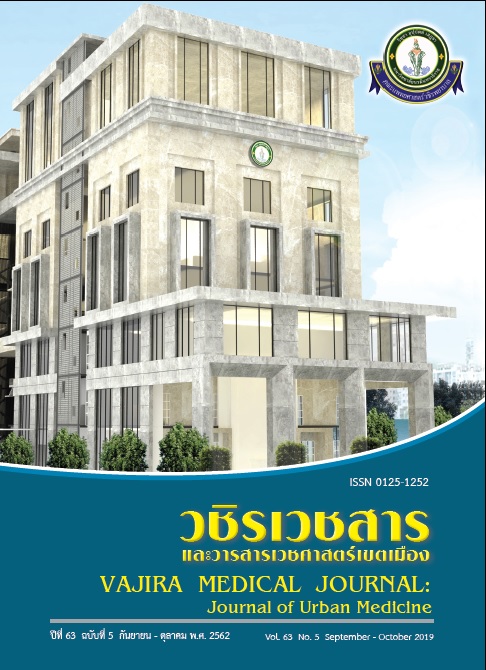Anti-Proliferation and Anti-Migration Effect of a Medicinal Mushroom, Schizophyllum Commune, on Human Cholangiocarcinoma Cell Line
Main Article Content
Abstract
Objective: To investigate the possible anti-proliferation and anti-migration effect of the crude extracts from Schizophyllum commune against human cholangiocarcinoma cell line, KKU-M213
Methods: In this study, dried fruiting bodies of S. commune were extracted with 95% ethanol and water. Antiproliferative activity of the crude extracts from S. commune against human cholangiocarcinoma cell line, KKU-M213 was assessed by 3-(4, 5-dimethylthiazol-2-yl)-2, diphenyl tetrazolium bromide (MTT) assay. Wound healing assay was used for investigating the effects of the mushrooms crude extracts on KKU-M213 cell migration.
Results: The percentage yields of S. commune ethanol and water extracts were 5.42 % and 7.78 %, respectively. The results of MTT assay showed that 200 µg/ml of ethanol crude extracts significantly inhibited proliferation of KKU-M213 to 50% compared to untreated control. While hot water extracts of S. commune did not have any effects on KKU-M213 cell proliferation. Wound healing assay result showed that both hot water and ethanolic extracts of S. commune suppressed KKU-M213 cell migration.
Conclusion: This is the first report showing the anti-proliferation and anti-migration activity of this mushroom against human cholangiocarcinoma.
Downloads
Article Details
References
Sripa B, Pairojkul C. Cholangiocarcinoma: lessons from Thailand. Current opinion in gastroenterology. 2008;24(3):349-56.
Sripa B, Bethony JM, Sithithaworn P, Kaewkes S, Mairiang E, Loukas A, et al. Opisthorchiasis and Opisthorchis-associated cholangiocarcinoma in Thailand and Laos. Acta tropica. 2011;120 Suppl 1:S158-68.
Aumkhae S. Role of Systemic Chemotherapy in Advanced Cholangiocarcinoma. Srinagarind Medical Journal. 2012;27(3):351-5.
Seema Patel AG. Recent developments in mushrooms as anti-cancer therapeutics: a review. 3 Biotech. 2012;2:1-15.
Joseph TP, Chanda W, Padhiar AA, Batool S, LiQun S, Zhong M, et al. A Preclinical Evaluation of the Antitumor Activities of Edible and Medicinal Mushrooms: A Molecular Insight. Integrative cancer therapies. 2018;17(2):200-9.
T.S. Ivanova TAK, V.Y. Barshteyn, A.B. Artamonova, and V.A. Shlyakhovenko. Anticancer substances of mushroom origin. Experimental Oncology. 2014;36(2):58-66.
Borchers AT, Stern JS, Hackman RM, Keen CL, Gershwin ME. Mushrooms, tumors, and immunity. Proceedings of the Society for Experimental Biology and Medicine Society for Experimental Biology and Medicine. 1999;221(4):281-93.
Kawagishi H, Mori H, Uno A, Kimura A, Chiba S. A sialic acid-binding lectin from the mushroom Hericium erinaceum. FEBS letters. 1994;340(1-2):56-8.
Tripathi AM, Tiwary BN. Biochemical constituents of a wild strain of Schizophyllum commune isolated from Achanakmar-Amarkantak Biosphere Reserve (ABR), India. World journal of microbiology & biotechnology. 2013;29(8): 1431-42.
Chumkhunthod P, Rodtong S, Lambert SJ, Fordham-Skelton AP, Rizkallah PJ, Wilkinson MC, et al. Purification and characterization of an N-acetyl-D-galactosamine-specific lectin from the edible mushroom Schizophyllum commune. Biochimica et biophysica acta. 2006;1760(3): 326-32.
Liu X, Frydenvang K, Liu H, Zhai L, Chen M, Olsen CE, et al. Iminolactones from Schizophyllum commune. Journal of natural products. 2015;78(5): 1165-8.
Luapattarakasem P. Role of Natural Products on Cancer Prevention and Treatment. Srinagarind Med J. 2005;20(3):180-9.
Hu H, Zhang Z, Lei Z, Yang Y, Sugiura N. Comparative study of antioxidant activity and antiproliferative effect of hot water and ethanol extracts from the mushroom Inonotus obliquus. Journal of bioscience and bioengineering. 2009; 107(1):42-8.
Victor E.Vaskovsky SVK, Eugenya M.Boolugh. Distribution of diacylglycerotrimethylhomoserine and phosphotidylcholine in mushrooms. Phytochemistry. 1998;47 (5):755-60.
Lemieszek M, Rzeski W. Anticancer properties of polysaccharides isolated from fungi of the Basidiomycetes class. Contemporary oncology. 2012;16(4):285-9.
Arvind K. Sharma MG, Archana Shrivastav and A.M. Jana. Antioxidant and anticancer therapeutic potentiality of mushrooms: a review. Int J Pharm Sci Res. 2013;4(10):3795-802.
Wasser SP. Current findings, future trends, and unsolved problemsin studies of medicinal mushrooms. Appl Microbiol Biotechnol 2011; 89:1223-32.
Mirfat A.H.S. NAaVS. Scavenging activity of Schizophyllum commune extracts and its correlation to total phenolic content. J Trop Agric and Fd Sc 2010;38(2):231– 8.
Xu DP, Zheng J, Zhou Y, Li Y, Li S, Li HB. Extraction of Natural Antioxidants from the Thelephora ganbajun Mushroom by an Ultrasound-Assisted Extraction Technique and Evaluation of Antiproliferative Activity of the Extract against Human Cancer Cells. International journal of molecular sciences. 2016;17(10).
Klaus A.; Kozarski M.; Niksic M.; Jakovljevic D.; Todorovic NvG, L.J.L.D. Antioxidative activities and chemical characterization of polysaccharides extracted from the basidiomycete Schizophyllum commune. LWT Food Sci Technol 2011;44(10): 2005–11.
Du B, Yang Y, Bian Z, Xu B. Characterization and Anti-Inflammatory Potential of an Exopolysaccharide from Submerged Mycelial Culture of Schizophyllum commune. Frontiers in pharmacology. 2017;8:252.
Calabrese EJ. Cancer biology and hormesis: human tumor cell lines commonly display hormetic (biphasic) dose responses. Critical reviews in toxicology. 2005;35(6):463-582.
Son TG, Camandola S, Mattson MP. Hormetic dietary phytochemicals. Neuromolecular medicine. 2008;10(4):236-46.
Panthong S, Boonsathorn N, Chuchawankul S. Antioxidant activity, anti-proliferative activity, and amino acid profiles of ethanolic extracts of edible mushrooms. Genetics and molecular research : GMR. 2016;15(4).
Ying-Yi Chen P-YC, Yi-Chung Chien, Chieh-Hsi Wu, Tian-Shung Wu, and Ming-Jyh Sheu. Ethanol extracts of fruiting bodies of Antrodia cinnamomea exhibit anti-migration action in human adenocarcinoma CL1-0 cells through the MAPK and PI3K/AKT signaling pathways. Phytomedicine 2012;19:768-78.
Qu L, Li S, Zhuo Y, Chen J, Qin X, Guo G. Anticancer effect of triterpenes from Ganoderma lucidum in human prostate cancer cells. Oncology letters. 2017;14(6):7467-72.
Dragana S. Šeklić MSS, Milena G. Milutinović, Marina D. Topuzović, Andraš Š. Štajn, Snežana D. Marković. Cytotoxic, antimigratory, pro-and antioxidative activities of extracts from medicinal mushrooms on colon cancer cell lines. Arch Biol Sci, Belgrade. 2016;68(1):93-105.
Jedinak A, Sliva D. Pleurotus ostreatus inhibits proliferation of human breast and colon cancer cells through p53-dependent as well as p53-independent pathway. International journal of oncology. 2008;33(6):1307-13.
Youn MJ, Kim JK, Park SY, Kim Y, Kim SJ, Lee JS, et al. Chaga mushroom (Inonotus obliquus) induces G0/G1 arrest and apoptosis in human hepatoma HepG2 cells. World journal of gastroenterology. 2008;14(4):511-7.
Wu CH, Liu FC, Pan CH, Lai MT, Lan SJ, Wu CH, et al. Suppression of Cell Growth, Migration and Drug Resistance by Ethanolic Extract of Antrodia cinnamomea in Human Lung Cancer A549 Cells and C57BL/6J Allograft Tumor Model. International journal of molecular sciences. 2018;19(3).


